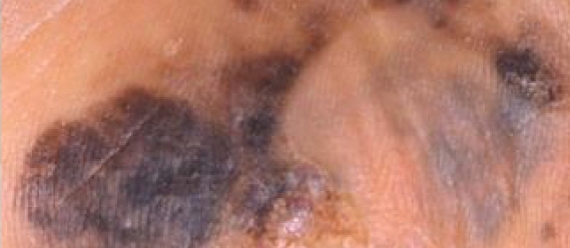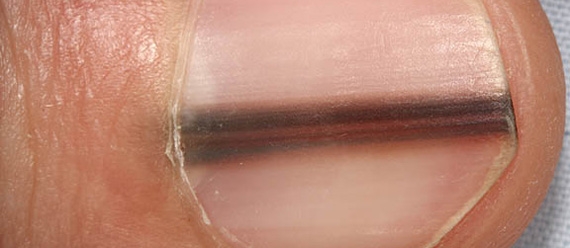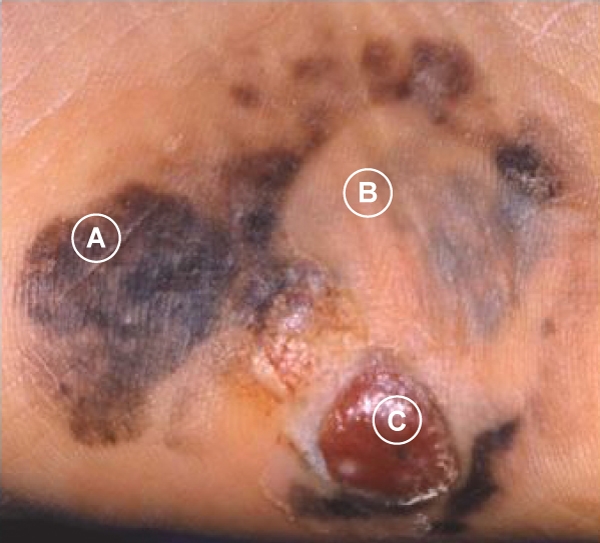Most of us learn the alphabet as young children and it becomes an innate part of our knowledge. We hardly ever think about these basic written symbols, but did you know that knowing your ABCs could potentially save your life?
Occasionally a patient will present to his or her podiatrist’s office concerned about a suspicious looking mark on his or her foot or toenail. This type of patient usually has had some sort of experience with melanoma, whether it’s a family member, friend, or even a personal history of the disease.
Often times however, a patient will present for issues such as heel pain or bunions, and a suspicious mark is found incidentally during a routine foot exam. It is very common that these patients are not familiar with the basis of melanoma, among the most life-threatening of skin cancers.
If you’re in the category of people who aren’t familiar with melanomas, don’t fret. I hope to give you some vital facts and tools that will help you increase your knowledge.
To keep it straight-forward, you should know that almost all melanomas start with a change in the appearance of normal-looking skin. Direct sun exposure and damage caused by UV light can break down our DNA, leading to the development of cancer. Melanoma is less common than other skin cancers, but much more dangerous. 75% of deaths related to skin cancer are caused by melanoma. In the foot, many cases of melanoma are missed since we often disregard our feet unless they cause problems. Foot melanoma is life threatening, but if caught early, it is potentially treatable.
Certain risk factors to be aware of that may put you at increased risk of developing melanoma include:
-UV light exposure (sun and tanning beds)
-Moles, dark spots
-Dark lines in nail and nail beds
-Fair skin, freckling, and light hair
-Family history of melanoma
-Personal history of melanoma
Diagnosing melanoma in the lower extremity is officially done by your podiatrist; however this doesn’t mean that you too shouldn’t take an active role in checking for any new lesions or previous lesions that are changing in appearance.
This brings me back to the ABCs. When looking at a lesion on your bodies (such as a mole or dark spot) always keep the following in mind and be on the lookout for early signs of melanoma:
Asymmetry: (symmetrical vs. asymmetrical) One half does not match the other half
Borders (even vs. uneven) The edges are notched or ragged
Color (single shade vs. many shades) Varied shared of tan, black and brown
Diameter: less than 6mm (normal), about the size of a pencil eraser or greater than 6mm (abnormal)
Evolving over time (flat vs. elevated) Change in size, shape or shade of color
A typical melanotic lesion may not exhibit each and every one of these points, however if your lower extremity lesion does fit these categories, have it checked out by your podiatrist. When you apply the ABCs to skin cancers (particularly melanoma), it really can make a difference between life and death. If you are physically unable to check for lesions, have someone help you out or go see your podiatrist who can perform a complete lower extremity exam.
Now that you are equipped with the knowledge of what makes you susceptible to developing melanoma and what you should be looking out for, let’s focus our attention on prevention:
– Minimize your exposure to UV light: if possible avoid the sun between 9AM-3PM, avoid tanning beds–don’t believe what others tell you about tanning beds, they too emit UV light!)
– If you are going to be outside, wear sun-protective clothing (long sleeved shirts, trousers, broad-brimmed hats) and sunglasses with UV protection
– Sunscreen: look for SPF 30 or above, also for ingredients such as avobenzone, zinc, and titanium; if you are of a darker complexion, you too should be applying sunscreen as it has proven to protect against other types of skin cancers.
–Daily skin checks: use a mirror for your body front and back with arms raised; with elbows bent inspect forearms, back of upper arms, and palms; look at the back of your legs and feet, don’t forget your toenails, the spaces in between your toes and the soles of your feet; inspect the back of your neck and scalp with hand mirror
–Yearly checks: visit your Podiatrist for lower extremity skin checks to ensure your dark spots are benign; keep in mind that in women, melanoma is most commonly found in the legs, ankles, and feet
Melanoma is a rare but very serious condition. Now that you know more about this life-threatening disease, share your knowledge with others and help in the prevention. There are several melanoma apps that can help you with your daily skin lesion checks (in case you haven’t already memorized the ABCs of melanoma).




